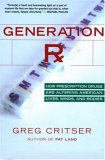Summary | Excerpt | Reviews | Beyond the Book | Readalikes | Genres & Themes | Author Bio

Critics' Opinion:
Readers' Opinion:
First Published:
Oct 2005, 288 pages
Paperback:
Jan 2007, 320 pages
 Book Reviewed by:
Book Reviewed by:
BookBrowse Review Team
Buy This Book
But Haddad's biggest beef with the
industry — and the FDA —
had provoked little in the way of
action. By 1982 there was still no workable
economic method for getting a generic
drug approved even after a patent ran
out. That was because the FDA still
required any maker of a generic version
of a brand-name drug to undertake the
same lengthy, costly, and sometimes
dangerous series of clinical trials to
prove its product was safe and
efficacious. Technically, this process
was totally unnecessary. Time-proven
methods of reverse engineering, along
with sophisticated ways of assaying
copycat compounds, could assure that any
generic was biologically
equivalent. "It was totally immoral to
insist that the generic maker do all that
again," Haddad argued. "But they don't
care . . . they don't care about the
senior citizens, they don't care about
the poor single mother, they don't
care . . ." Many inside the FDA agreed,
but the political power of the PMA,
along with institutional inertia,
cowardice, and plain old bureaucratic ass-
covering had precluded any meaningful
reform.
Then, in mid-1982, just as the PMA and
Engman were using a
new, ostensibly "independent" study to
convince Congress that patent life
had been dramatically shortened by FDA
red tape, Haddad got a letter from a
woman in Florida, a statistician who
claimed she had been an author of the
supposedly independent study. "She said
that not only had the numbers for
the study been prepared for her by the
industry, but that the brand names
had paid for the study and then insisted
that it be presented
as 'independent.'" Haddad used the
disclosure to stir up discontented seniors
in two Miami Beach districts, who in
turn "drove their congressman crazy"
about why patent restoration was wrong,
not to mention political suicide.
Using Haddad's activism to mobilize
opposition votes and Al Gore's
willingness to vilify the industry in
general, Waxman defeated Engman's
patent-extension legislation.
For a time following his defeat, Engman
worked on a number of
other industry-relief efforts. Certainly
the time was still right for anything that
offered a way to make the nation more
competitive. Congress had passed the
Bayh-Dole Act in 1981, which made it
easier for the industry to use research
discoveries that originated in publicly
funded laboratories. For pharma, that
opened up a wide range of lucrative
partnerships with researchers at the
National Institutes of Health (NIH),
where scientists were making
breakthroughs in developing new
molecules that could treat everything from
heart disease to depression. The law
also made it possible for government
researchers to accept consulting fees
from pharmaceutical companies.
This opening-up process — in essence
doing away with old
church-state separations that favored
institutional or scientific independence
over commerce of almost any kind — was
the subject of a lengthy inquiry
from some of the nation's leading
experts in pharmacology and drug
regulation, who were joined by Engman.
Commenced in the late 1970s under
Tulane University's Dr. Gilbert McMahon,
the Commission on the Federal
Drug Approval Process was originally
created as an evenhanded, fact-finding
mission to discern whether many of the
industry's complaints about the FDA
were justified. Under Reagan, it
essentially became an industry organ,
funded
not by the government but — under the
guise of budgetary efficiency — by
private interests and philanthropists in
tune with the president's deregulatory
impulses. As a result, the commission's
official discussions about opening
up the FDA took place off the record and
out of media view at a Virginia
resort owned by a friend of the president.
By the time the commission presented
its report in late 1982,
almost every discordant (i.e.,
anti–brand name) note had been tuned out.
Instead, what Congress heard was a
venerable choir of scientific voices
demanding that the FDA cut the red tape
and speed up approvals. The
commission then presented Congress with
its list of recommendations, many
of which would eventually make it into
the law books. Instead of requiring
extensive, multiple studies for
approval, the commission asked
that "effectiveness should be found to
have been demonstrated either by
two — or, when appropriate, one —
adequately designed and well-controlled
studies." Foreign studies should also be
admissible and given equal weight
with domestic studies, even if the
populations were different. The commission
also advised lifting stodgy old
conflict-of-interest restrictions that
barred the
use of industry-paid experts in FDA
advisory committee meetings.
Lastly, "the FDA should provide guidance
to its staff to encourage all review
personnel to conduct timely, forthright,
and evenhanded discussions with
sponsors that arise at any time during
the review process."
Copyright © 2005 by Greg Critser. Reprinted by permission of Houghton Mifflin Company.





The Flower Sisters
by Michelle Collins Anderson
From the new Fannie Flagg of the Ozarks, a richly-woven story of family, forgiveness, and reinvention.

The House on Biscayne Bay
by Chanel Cleeton
As death stalks a gothic mansion in Miami, the lives of two women intertwine as the past and present collide.

The Funeral Cryer by Wenyan Lu
Debut novelist Wenyan Lu brings us this witty yet profound story about one woman's midlife reawakening in contemporary rural China.
Your guide toexceptional books
BookBrowse seeks out and recommends the best in contemporary fiction and nonfiction—books that not only engage and entertain but also deepen our understanding of ourselves and the world around us.